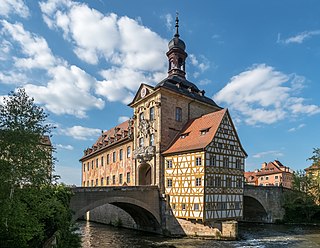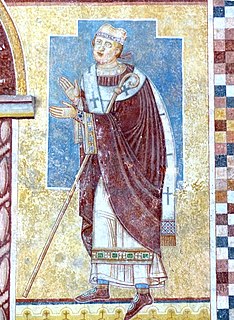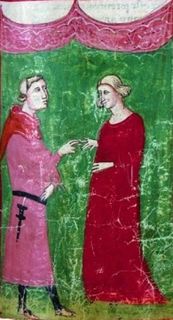Related Research Articles

Bamberg is a town in Upper Franconia, Germany, on the river Regnitz close to its confluence with the river Main. The town dates back to the 9th century, when its name was derived from the nearby Babenberch castle. Cited as one of Germany's most beautiful towns, its old town has been a UNESCO World Heritage Site since 1993, with Bamberg being home to Europe's largest intact old city wall.

Babenberg was a noble dynasty of Austrian margraves and dukes. Originally from Bamberg in the Duchy of Franconia, the Babenbergs ruled the Imperial Margraviate of Austria from its creation in 976 AD until its elevation to a duchy in 1156, and from then until the extinction of the line in 1246, whereafter they were succeeded by the House of Habsburg.

Conrad III of the Hohenstaufen dynasty was from 1116 to 1120 Duke of Franconia, from 1127 to 1135 anti-king of his predecessor Lothair III and from 1138 until his death in 1152 king in the Holy Roman Empire. He was the son of Duke Frederick I of Swabia and Agnes, a daughter of the Salian Emperor Henry IV.

Otto of Bamberg was German missionary and papal legate who converted much of medieval Pomerania to Christianity. He was the bishop of Bamberg from 1102 until his death. He was canonzied in 1189.
Philip of Swabia was a member of the House of Hohenstaufen and king of Germany from 1198 until his assassination.

Welf II, or Welfhard, called Welf the Fat (pinguis), was Duke of Bavaria from 1101 until his death. In the Welf genealogy, he is counted as Welf V.
Frederick I was the Archbishop of Cologne from 1100 until his death.

Bertha of Savoy, also called Bertha of Turin, was Queen consort of Germany from 1066 and Holy Roman Empress from 1084 until 1087 as the first wife of the Salian emperor Henry IV.

Otto I, a member of the House of Andechs, was Duke of Merania from 1204 until his death. He was also Count of Burgundy from 1208 to 1231, by his marriage to Countess Beatrice II, and Margrave of Istria and Carniola from 1228 until his death.

The Prince-Bishopric of Bamberg was an ecclesiastical State of the Holy Roman Empire. It goes back to the Roman Catholic Diocese of Bamberg established at the 1007 synod in Frankfurt, at the behest of King Henry II to further expand the spread of Christianity in the Franconian lands. The bishops obtained the status of Imperial immediacy about 1245 and ruled their estates as Prince-bishops until they were subsumed to the Electorate of Bavaria in the course of the German Mediatisation in 1802.
The Great Saxon Revolt was a civil war fought between 1077 and 1088, early in the history of the Holy Roman Empire. The revolt was led by a group of opportunistic German princes who elected as their figurehead the duke of Swabia, Rudolf of Rheinfeld, who became the anti-king. Rudolf was a two-way brother-in-law of the young Henry IV, Holy Roman Emperor, who had been crowned at the age of six and had taken the reins of power at age sixteen. The Great Revolt followed the Saxon Rebellion of 1073–75.
Starting in the 12th century, the Margraviate, later Electorate, of Brandenburg was in conflict with the neighboring Duchy of Pomerania over frontier territories claimed by them both, and over the status of the Pomeranian duchy, which Brandenburg claimed as a fief, whereas Pomerania claimed Imperial immediacy. The conflict frequently turned into open war, and despite occasional success, none of the parties prevailed permanently until the House of Pomerania died out in 1637. Brandenburg would by then have naturally have prevailed, but this was hindered by the contemporary Swedish occupation of Pomerania, and the conflict continued between Sweden and Brandenburg-Prussia until 1815, when Prussia incorporated Swedish Pomerania into her Province of Pomerania.

Henry V, was King of Germany and Holy Roman Emperor, as the fourth and last ruler of the Salian dynasty. He was made co-ruler by his father, Henry IV, in 1098.

Henry IV was Holy Roman Emperor from 1084 to 1105, King of Germany from 1054 to 1105, King of Italy and Burgundy from 1056 to 1105, and Duke of Bavaria from 1052 to 1054. He was the son of Henry III, Holy Roman Emperor—the second monarch of the Salian dynasty—and Agnes of Poitou. After his father's death on 5 October 1056, Henry was placed under his mother's guardianship. She made grants to German aristocrats to secure their support. Unlike her late husband, she could not control the election of the popes, thus the idea of the "liberty of the Church" strengthened during her rule. Taking advantage of her weakness, Archbishop Anno II of Cologne kidnapped Henry in April 1062. He administered Germany until Henry came of age in 1065.

The Gunthertuch is a Byzantine silk tapestry which represents the triumphal return of a Byzantine Emperor from a victorious campaign. The piece was purchased, or possibly received as a gift, by Gunther von Bamberg, Bishop of Bamberg, during his 1064–65 pilgrimage to the Holy Land. Gunther died on his return journey, and was buried with it in the Bamberg Cathedral. The fabric was rediscovered in 1830, and is now exhibited in the Bamberg Diocesan Museum.

Gunther was a German nobleman and prelate of the Holy Roman Empire. He served as Chancellor of Italy from 1054 until 1057 and as Bishop of Bamberg from 1057 until his death. He was the leader of the Great German Pilgrimage of 1064–65, on which he died.
Sigehard or Sieghard was patriarch of Aquileia from 1068 to 1077. He was the member of a Bavarian noble family with estates in Chiemgau.
Widerad was abbot of Fulda Abbey. His dispute over precedence with Bishop Hezilo of Hildesheim contributed to the loss of significant parts of the estates of the abbey.
Tedald was archbishop of Milan from 1075 to 1085.
The Synod of Brixen was a church council held on 15 June 1080 in the episcopal city of Brixen. It was convoked by King Henry IV of Germany at the height of the Investiture Controversy to pass judgement on Pope Gregory VII. The synod issued a decree condemning the pope, demanding his abdication and authorizing his deposition if he refused. The synod also elected his successor, Wibert of Ravenna.
References
- ↑ Robinson 2003, pp. 116, 137.
- ↑ Brook 2014, p. 347.
- ↑ Robinson 2003, p. 119.